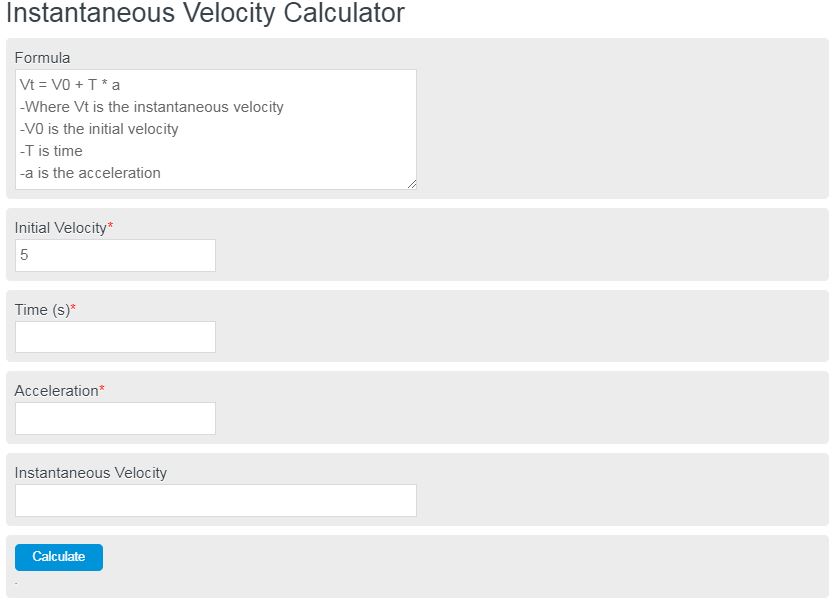Calculate the instantaneous velocity of an object using this instantaneous velocity calculator. Enter the initial velocity, acceleration, and time past to calculate the velocity at a given time. This calculator can evaluate the initial velocity, time, or acceleration, given the other variables are known.
- All Velocity Calculators
- Acceleration Calculator
- Velocity Calculator
- Angular Acceleration Calculator
- Angular Velocity Calculator
- Final Velocity Calculator
- Instantaneous Power Calculator
Instantaneous Velocity Formula
The following formula can be used to calculated the velocity of an object at any given point in time assuming initial time = 0.
Vt = V_0 + T * a
- Where Vt is the instantaneous velocity
- V0 is the initial velocity
- T is time
- and a is acceleration
To calculate instantaneous velocity, multiply the acceleration by time, then add the result to the initial velocity.
Instantaneous Velocity Definition
Instantaneous velocity is a term in physics used to describe the velocity, also known as the change in distance over time, at a specific point in time. An object undergoing acceleration will have different instantaneous velocities at different points in time. This is because acceleration is the rate of change of velocity, so that says that velocity is in fact changing.
Instantaneous velocity can be found through two different methods. The first being through calculations and formulas. One of those formulas is presented above. Another formula that you can use is to take the derivative of acceleration with respect to time, at the specific time you wish to calculate the velocity.
The other method to calculate instantaneous velocity is through measurement using things like a speedometer. This is often done for things like measuring the speed of a car or
How to calculate instantaneous Velocity
The following example is a step-by-step guide on how to calculate the instantaneous velocity of an object. For this example, we will assume an object has an initial velocity and some constant acceleration.
- First, we must measure the initial velocity. We will say for this example that this is a car moving along the street. At a time of t=0 seconds, we find the car to be moving at 30 m/s.
- Next, we must determine the acceleration of the car. To simplify the problem, we will assume that we know the acceleration, as calculating it from the force of the engine and other factors would be a problem on its own. We find the acceleration is 5 m/s^2.
- Now, the total time that has passed needs to be determined. For this example, 10 seconds have passed.
- Finally, enter the information into the formula above. V= 30m/s + 10s * 5 m/s^2 = 80m/s.
- Analyze the results and apply them to future problems.
FAQ
Instantaneous velocity is a term in physics used to describe the velocity, also known as the change in distance over time, at a specific point in time. An object undergoing acceleration will have different instantaneous velocities at different points in time. This is because acceleration is the rate of change of velocity, so that says that velocity is in fact changing.

